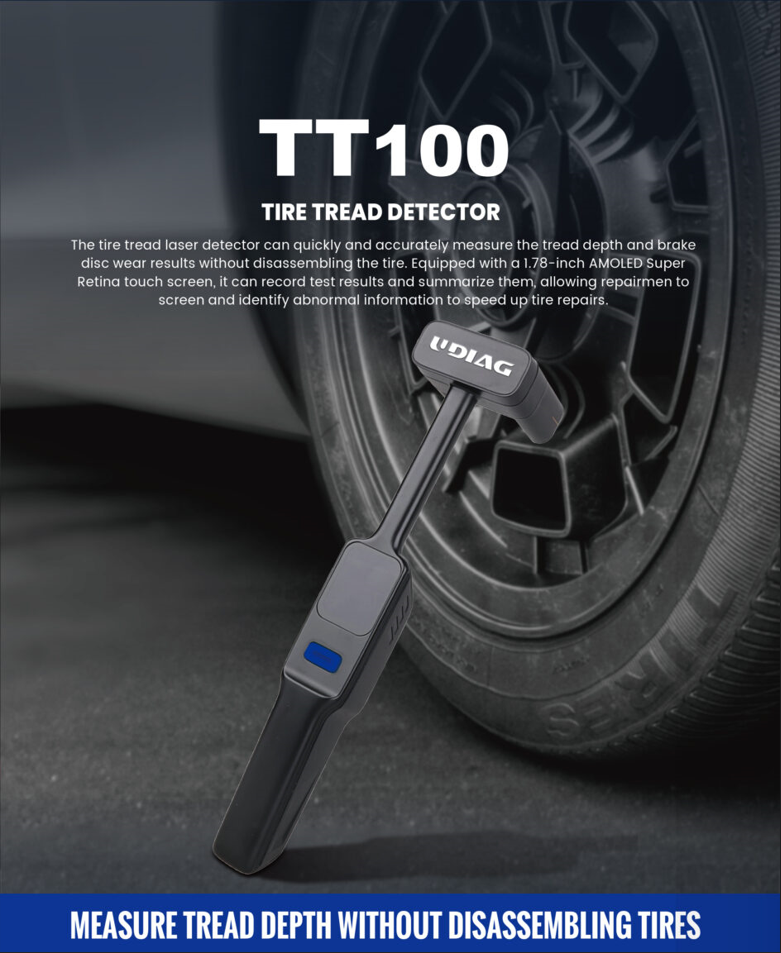Can tire tread detectors help in predicting tire failures or blowouts in autonomous vehicles?
2024-03-25 by UDIAG
Autonomous vehicles represent a significant advancement in transportation technology, promising increased safety and efficiency on the roads. However, ensuring the safety of these vehicles requires meticulous attention to various components, with tire health being of paramount importance. Tire failures and blowouts can pose serious risks to both occupants of autonomous vehicles and other road users. In this context, tire tread detectors emerge as a promising solution to enhance predictive maintenance and mitigate the risk of tire-related incidents in autonomous vehicles.

I. Tire Failures and Blowouts
Tire failures and blowouts are critical safety concerns for any vehicle, including autonomous ones. These incidents can result from various factors such as wear and tear, improper inflation, road hazards, and manufacturing defects. The consequences of tire failures and blowouts in autonomous vehicles extend beyond mere inconvenience, potentially leading to accidents, injuries, and even fatalities.
II. Tire Tread Detectors
Tire tread detectors are innovative technologies designed to monitor the condition of tire treads in real-time. They come in various forms, including sensors embedded in the tires or external devices that analyze tread patterns. These detectors work by measuring tread depth, analyzing tread wear patterns, and detecting anomalies that may indicate potential tire issues. By providing continuous monitoring, tire tread detectors offer valuable insights into tire health and enable proactive maintenance.
III. Predictive Capabilities of Tire Tread Detectors
One of the primary advantages of tire tread detectors is their predictive capabilities regarding tire failures and blowouts. By analyzing tread depth and wear patterns, these detectors can identify signs of tire deterioration before they escalate into critical issues. For example, abnormal wear patterns or significant tread depth reductions may indicate uneven tire pressure, misalignment, or other underlying problems that could lead to failures if left unaddressed. Case studies have demonstrated the effectiveness of tire tread detectors in predicting tire failures and preventing accidents, thereby highlighting their potential in enhancing autonomous vehicle safety.
IV. Challenges and Limitations
Despite their benefits, tire tread detectors also face certain challenges and limitations. Environmental factors such as extreme weather conditions, road surface variations, and debris may affect the accuracy of tread measurements and predictions. Moreover, technological limitations and integration challenges may hinder the widespread adoption of tire tread detectors in autonomous vehicles. Addressing these challenges requires ongoing research and development efforts to improve the reliability and robustness of tire tread detection systems.
V. Integration with Autonomous Vehicle Systems
Integrating tire tread detectors with autonomous vehicle systems is crucial for maximizing their effectiveness in enhancing safety. By incorporating tire health monitoring into onboard diagnostics and control systems, autonomous vehicles can proactively manage tire-related issues and adjust driving behavior accordingly. For instance, real-time data from tire tread detectors can inform autonomous driving algorithms to adapt speed and handling characteristics based on tire conditions, thereby optimizing vehicle performance and safety.
VI. Future Outlook
The future of tire tread detectors in autonomous vehicles holds promise for further advancements in predictive maintenance and safety. Emerging technologies such as artificial intelligence and machine learning offer opportunities to enhance the predictive capabilities of tire tread detectors and enable more accurate risk assessments. Additionally, ongoing research and collaboration within the automotive industry are likely to drive innovation in tire health monitoring systems, paving the way for safer and more reliable autonomous vehicles.
Conclusion
In conclusion, tire tread detectors represent a critical component in the pursuit of safer autonomous vehicles. By providing real-time insights into tire health and predicting potential failures, these detectors play a vital role in mitigating the risk of tire-related incidents on the roads. Despite facing challenges and limitations, tire tread detectors hold immense potential for enhancing autonomous vehicle safety and paving the way towards a future of safer and more reliable transportation.
FAQs
1. How do tire tread detectors work?
Tire tread detectors utilize advanced sensor technologies to measure tread depth and assess tire condition, providing real-time data to vehicle systems.
2. Can tire tread detectors prevent all tire-related accidents?
While tire tread detectors significantly reduce the risk of accidents, they cannot eliminate all potential tire-related issues. However, they play a crucial role in minimizing risks and enhancing overall safety.
3. Are tire tread detectors suitable for all types of vehicles?
Tire tread detectors can be adapted for various vehicle types, including autonomous cars, trucks, and buses. However, their effectiveness may vary depending on factors such as road conditions and environmental variables.
4. How often should tire tread be inspected in autonomous vehicles?
Regular tire tread inspections are essential for maintaining vehicle safety. The frequency of inspections may vary based on usage patterns, but it is recommended to conduct thorough checks at least once every few weeks.
5. Can tire tread detectors integrate with existing vehicle systems seamlessly?
Modern tire tread detectors are designed to integrate seamlessly with existing vehicle platforms, leveraging standardized communication protocols for data exchange and interoperability.
6. What role do tire manufacturers play in advancing tire tread detection technology?
Tire manufacturers collaborate with automotive companies and technology providers to develop and refine tire tread detection systems, ensuring compatibility, accuracy, and reliability across diverse vehicle fleets.


